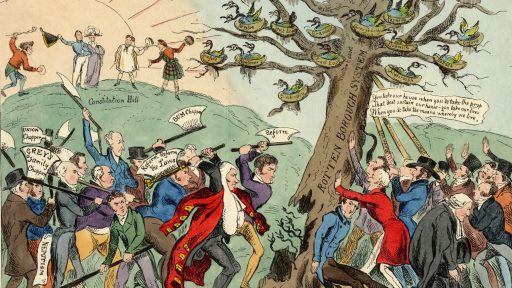“If the U.S. is the butt of global jokes, they are aimed at the level of competence in America, which has decreased in the years since we instituted a Department of Education.” – Bill Bennett and Lamar Alexander
Hillary Rodham Clinton’s It Takes A Village suggests that all members of the community are responsible for America’s children. However, according to Clinton, a disproportionate responsibility rests, not with the family, but with government-run public schools. With the Department of Education (DOE), a village pillar was created by the government to assist public schools in their role of developing children. Yet, it has recently come under fire for its failures.
Budget cutting efforts, long overdue, have focused on the elimination of the DOE. The strident protests from members of the Clinton administration and the education establishment would seem curious if not for their village paradigm. Unwilling to consider a reduced role for the schools, and to concede that parents are the ones primarily responsible for the development of their children, the administration cannot conscience material changes to American education for fear that the most important member of their village will be undermined.
Members of our generation, more than any other, have experienced government-run public schools first hand. We should ask ourselves, “are they as bad as some say?” And if so, “what should we do about them?” History is revealing. In 1940, teachers concerned themselves with students talking out of turn, chewing gum, making noise, running in the hall, cutting in line, violating the dress code, and littering. Today, the biggest problems identified by teachers are drug use, alcohol abuse, pregnancy, suicide, rape, robbery, and assault.(1) Either the current system is part of the problem, or part of the solution. If part of the problem, it must not be protected from necessary changes; and the evidence is condemning.
In light of its mission “to ensure access to education and promote educational excellence throughout the nation,”(2) DOE’s expenditures are suspect. The village, it seems, isn’t getting much smarter. For example, far from promoting educational excellence, the DOE has had little, if any, positive effect on the nation’s standardized test scores. In fact, since the department’s inception in 1979, test scores among our nation’s school children have plummeted. Other studies indicate that if anything, American students are suffering a serious case of academic mediocrity.
Though its annual budget of only $32 billion places it among the smallest cabinet agencies, evidence of waste and inefficiency in the Department of Education abounds. The Government Accounting Office reports that many of the department’s programs are duplicated elsewhere. In addition to the $32 billion consumed by the DOE, the federal government spends $70 billion on thirty other federal agencies and 308 programs that affect education. According to former assistant Secretary of Education Diane Ravitch, “this is a tail that wags a big dog.”(3) Currently the department manages about 250 federal education programs, many of which have more to do with social programming than education. While most of the department’s employees mean well, according to Ravitch, “most know less about education than the average teacher.”(4 )
DOE’s relatively limited funding has not stopped it from having a tremendous negative impact on America’s children. According to data presented in 1988 by the National Assessment of Educational Progress (NAEP), just five percent of seventeen year old students could read well enough to understand college-level textbooks. In 1986, ninety-four percent of eleventh graders could not do basic algebra, sixty percent of eleventh graders did not know why the Federalist Papers were written, and three-quarters of the students could not say when Abraham Lincoln was President.(5)
The dilapidated condition of government-run education is far from the vision of Horace Mann, known as the father of the American public school system. According to his biography,
Mann predicted nothing less for the future than ultimate human perfectibility…. It was … up to enlightened men and women, fully exercising their reason and their free will, to turn away from selfish ends and construct a world free from war, poverty, disease, and religious and political persecution. To achieve such a millennium, modern men would require educational institutions of the highest order … [to] rise above denominational rivalries, partisan interests, and class prejudices, and usher in a new golden age of peace, justice, and well-being.(6)
Even the liberal Horace Mann would likely be troubled by the state of modern government education.
The NEA Gets Paid
How did we get to this place? The DOE’s creation was part of a political payback. In July of 1976, the nation’s largest teacher’s union, the National Education Association (NEA), did something at its annual convention that it had not done in its 119-year history: it endorsed a presidential candidate — the eventual winner Jimmy Carter. In exchange for this endorsement, Carter promised to create a cabinet-level position for the Education Department, a key element of the NEA’s long term strategy. In spite of some legislative obstacles, Carter and the NEA were eventually victorious, and on October 17, 1979, he signed legislation creating the United States Department of Education. What a way to build a village.(7)
The Department of Education vs. the Constitution
Apart from mounting evidence that the DOE is wasteful and inefficient, the most compelling argument against it is the absence of a constitutional basis for its existence. Although education has always been a primary concern of the federal government, it has not always been a federal responsibility. The Northwest Ordinance, written just one year before the Constitution, stated that “Religion, morality and knowledge being necessary to good government…. schools and the means of education shall forever be encouraged.”(8) When the authors of the Ordinance penned the most important document in the history of government the U.S. Constitution they could have declared education to be a function of the federal government, but they did not. On education, the document is silent.
No mention of education, coupled with the Tenth Amendment which reads, “powers not delegated to the United States by the Constitution, nor prohibited by it to the states, are reserved to the states respectively, or to the people,”(9) makes it clear that control of education is not a part of the federal government’s jurisdiction. Education is reserved to the states and the people. While there is much precedent, and even necessity, for the promotion of education by the federal government, there is no constitutional basis for government control of local education policy.
What Now?
In recent months, many in Congress have attempted to radically alter, or even close, the DOE. Budget battles rage, and in their midst, debate over the value of the DOE continues. There is no lack of opposition to such ideas. Current Education Secretary Richard Riley warns that such a step would “hinder the ability of American students to advance in a competitive global economy.” He added that “education seems to be becoming a political target,” and called the proposal to eliminate his department “extreme and clearly short-sighted.”(10) In response, former Education Secretaries William Bennett and Lamar Alexander maintain that “if the U.S. is the butt of global jokes, they are aimed at the level of competence in America, which has decreased in the years since we instituted a Department of Education.” They concurred that ending the department’s reign would “do more to help education than its continuation.”(11)
Clearly, the educational system in America is in serious disrepair. Despite its efforts, the DOE has produced little more than declining test scores and increasing dropout rates at taxpayers’ expense. Efforts to remedy the situation have failed. Regardless of the prestige ascribed to the Department, it appears the village prince has produced only village idiots.
Endnotes
- William Bennett, “Redeeming Our Time,” Imprimis 24, (November 1995, 1-8).
- The U.S. Government Manual, 1994/95, (Washington, D.C.: Office of the Federal Register, National Archives and Records Administration, 1995), 267.
- Diane Ravitch, “Euthanasia: The U.S. Department of Education Should Be Abolished,” Forbes, (22 May 1995).
- Ibid.
- Chester E. Finn, Jr., We Must Take Charge, (New York: The Free Press, 1991).
- Jonathan Messerli, Horace Mann: A Biography, (New York: Alfred A. Knopt, 1972), 546.
- Facts on File, (New York: Fact on File, 1979), 782.
- Quoted in William M. French, America’s Educational Tradition, (Lexington, MA: D.C. Heath & Co., 1964).
- Constitution, amend. X.
- William F. Buckley, “Disassembling Education,” National Review, (6 March 1995), 78.
- Ibid.





